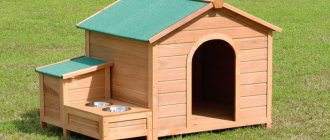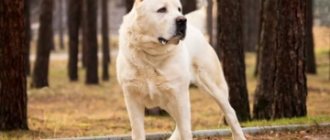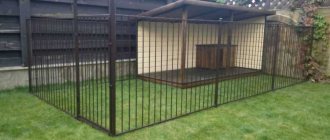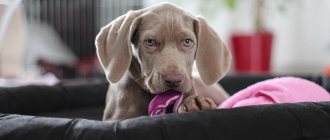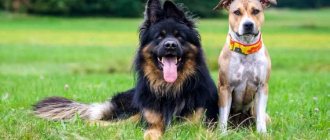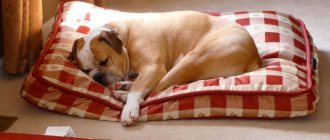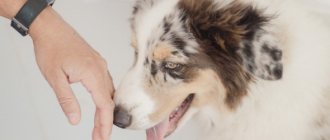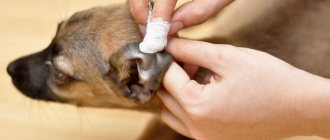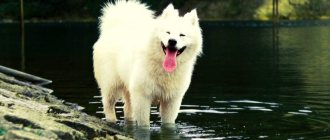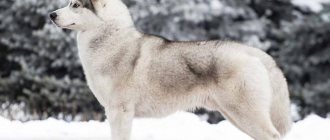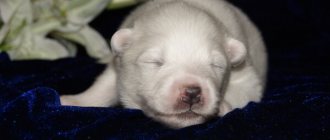Among dog breeds, huskies are very popular. Although these pets have been around for quite some time, they are especially in demand today. Initially, they were bred specifically for harnessing. Huskies are active and friendly pets. Their temperament does not allow them to sit on a leash. These dogs are very freedom-loving.
Since huskies grow quite quickly, they cannot be kept indoors. If you place a dog in cramped conditions, it becomes a pest. This manifests itself mainly in damage to furniture. Therefore, she should equip her own home. The dimensions of the booth and enclosure for a husky should be chosen very carefully.
Advantages
An enclosure for a husky is a necessary item in a private household.
An active, but freedom-loving animal should have the opportunity for independent games and activities, and not languish on a chain in the periods between rare walks.
Living outside in a personal space will relieve the dog from the disturbing presence of other types of pets, heat in the rooms, and noise.
Living outside, but in comfortable conditions, maintains the health of the animal and allows it to adapt to climatic conditions.
Considering the fact that the Laika is a hunting dog and spends several days in the forest, it will be prepared for the upcoming loads.
For the owner, keeping the dog separate will ensure that the animal gets rid of fur on the furniture, barking during off-hours, and conflicts with cats.
Often, when guests visit, the dog has to be locked in other rooms, which embarrasses and disturbs the household.
Being in an enclosure with a walking area will reduce the time of additional walks, because the dog will be able to frolic and play independently.
Place for an enclosure for a husky
One of the main conditions for creating comfortable conditions for the dog is choosing a place. A lot depends on this. The dog will not only sleep in the enclosure. This place is intended for eating, daily living, games and observing the territory.
You need to constantly exercise your dog. They train and take her for walks every day. This allows the husky to feel that its owners need it. If these conditions are not met, the pet will get sick. Even the death of the dog is possible. This can be avoided by correctly placing the enclosure on the site. It is better to place it away from the street. However, a condition must be met - the dog should have a view of both the yard and the area beyond its borders.
A place is selected taking into account certain requirements - it must be well lit and dry. Ideally, there will be trees around the enclosure. However, they should not block the view of the territory. The shadows cast by the trees will protect the husky from the sun's rays during the summer heat.
It is prohibited to place a husky enclosure near structures that emit strong or unpleasant odors - latrines, pigsties, stables. It is important to exclude exposure of your pet to other irritating factors.
Components and parameters
The enclosure consists of a platform, a winter road and a booth, with a possible walking area.
The winter road consists of three blank wooden walls and one in the form of a lattice; connected by a roof and a platform.
The best option is when one of the walls of the winter road is also the wall of a residential or utility room. This will protect the home from strong winds and precipitation.
The winter road must have a nook or booth of such a size that the dog can only roll over or stretch out there..
This is especially true in the presence of frosty winters, since a large room does not retain heat well.
The platform is located under the roof so that it is protected from precipitation from any side. Sometimes, for the same purpose, they make a flat roof of the booth, on which the dog is placed.
Many owners, when making an enclosure with their own hands, prefer to fill the floor of the winter road with concrete or asphalt, but this is not suitable for huskies.
The dog should feel the natural surface under its feet. In addition, when asphalt heats up in the heat, it emits harmful fumes, and in the cold, concrete can cause a dog to catch a cold.
When arranging a home, the floor can be covered with crushed stone or covered with boards, leaving room for digging in the ground.
In addition to the winter road and platform, the enclosure may have a walking area surrounded by a net.
It is recommended to use a rigid mesh or bars for the enclosure. This will help avoid injury when the dog throws itself against the wall of the enclosure.
The size of the enclosure is chosen based on the size of the dogs. For a husky, it must be at least 8 meters long. The height of the enclosure is at least 2 meters.
There are often cases when adult huskies overcome a wall of up to 3 meters. In such cases, a solid roof or mesh will help.
When building an enclosure with your own hands, you should remember the location: it should face south, southeast. Turning north will lead to the winter road being constantly clogged with snow, and strong winds will significantly undermine the dog’s health.
Preparing to build a booth
Before you start building a doghouse for a husky, you must first decide on its location, design and size.
- The location of the booth plays an important role. Laikas are by nature very sociable and friendly dogs, so it is better to install the booth in a place in the garden where there is shade and from where the entire yard can be seen.
- The kennel for a husky should be designed in such a way that the dog can feel comfortable lying, sitting or standing in its home. In most cases, owners of huskies make the roof pitched so that the pet can observe the entire surrounding space of the yard. Often, remembering that huskies love outdoor games, their owners install a booth inside an enclosure with an area of 6 square meters. Under no circumstances should the floor of the enclosure be covered with asphalt or paving stones, since only natural soil or plank covering is beneficial for the dog’s health. In order for the husky to dig around in the ground to its fullest extent, you need to place a box with sand in the corner of the enclosure and accustom your pet to it.
- As mentioned above, the dimensions for the kennel are selected based on the fact that the dog should be comfortable in it in any position. Having measured the dimensions of the husky, you need to add at least 5 centimeters to the resulting dimensions, which will give the required value. It is best to make the entrance to the booth small, but sufficient so that the dog can easily get to his home.
Construction process
To build an enclosure with your own hands, you need minimal skill in working with a welding machine and building materials.
First of all, you should choose a place for the enclosure. The yard and gate should be clearly visible. At the same time, it should not be located next to the road so that the noise does not interfere with the dog’s sleep.
Before construction, a drawing of the future home is made.
Minimum dimensions:
The rectangle is divided into three parts, where 1.5 m is occupied by a winter road, another 1.5 m is a platform, and the rest is a platform.
The winter road and the platform are covered with boards, which are positioned slightly at an angle to make cleaning after the dog easier.
They build a booth, leaving a gap between its bottom and the floor for air circulation. The walls of the winter road are erected from wood, and the rafters are prepared.
Cover the roof with boards and then with covering material. It should be soft and absorb noise, so it is better to refrain from using metal tiles.
The door to the enclosure should open inward.
It is equipped with external and internal bolts, and for unforeseen cases, eyes are welded. This will allow you to use the padlock if the deadbolt becomes damaged.
Pour the foundation for the fence supports. Using a welding machine, a grid for the winter road and a frame for the net surrounding the walking area are made. They install it around the perimeter and secure the network. If necessary, tighten the free space at the top.
Materials
Before you start choosing a suitable layout, you should decide on the material . And there are quite a few options here. You can make the entire structure iron, or just the main frame. In this case, cover the walls, floor and ceiling with a different material. Wood will always be preferable. It will not cause allergic reactions and will create a favorable microclimate. The quality of the wood is of great importance.
To read: Important and proud little Yorkshire Terrier: breed colors and brief description
Check that the boards are perfectly smooth. They must be treated with a special compound that increases the service life of the material, and also treated against insects. It is advisable to look at the quality certificate of this company to be sure that no harmful chemicals are used in production.
The choice of flooring also deserves special attention. Many people simply choose a concrete floor . It is easy to clean, wash with a hose, and even if the need arises to update, such repairs will be inexpensive and will be durable.
This is a good option, but a wooden floor will be more comfortable for our Siberian pets, although it will also be more expensive. Wood does not heat up in the heat, as concrete does, and in winter it will not freeze.
As for the roof, soft tiles will be preferable as they absorb the sound of dripping rain or hail. The animal may be irritated by such sounds, and it will bark instead of sleeping and letting you and your neighbors rest. Be sure to leave a slight slope so that rainwater or melted snowdrift does not stagnate on the roof.
If you care about the appearance of the building, then you can refine it, cover it with paint or decorative trim. It’s better to forget about interior decoration. Your dog doesn't need to design his own apartment. The smell of paint can negatively affect his health; your furry guard will simply chew any decor and, at best, will not choke or get poisoned.
Important features of the structure
Arranging an enclosure has many nuances that will help provide the husky with a good home and make it easier for the owner to care for.
How comfortable the husky’s stay will be depends on its condition.
Tips for arranging a booth:
- the area of the booth corresponds to the size of the animal;
- whenever possible, coniferous wood is used for construction;
- in cold climates, double walls are made, placing insulation between them;
- removable roof makes cleaning easier;
The booth is located in the far corner of the winter road so that the animal can rest without interference if necessary.
An enclosure is the animal’s permanent habitat, so you should take care in advance of its convenience not only for the dog, but also for the owner.
Recommendations for arranging an enclosure:
- the wooden floor is laid towards the exit so that swept debris does not get clogged in the cracks;
- in the winter road there should be a place without a draft for rest;
- the presence of open ground, which is useful for satisfying the dog’s natural desire to rummage in the ground;
- instead of a foundation, supports can be dug deep into the ground;
- the mesh on the walking area is dug into the ground at least 20 cm, since huskies easily dig through walls;
By taking care of the little things in advance, you won’t have to waste time on alterations or put up with annoying inconveniences in the future.
An enclosure for a dog is not a luxury, but a necessary building.
Building it with your own hands is not difficult, and the material for it can be easily purchased at any hardware store or taken from what is available on the site.
Living separately makes life easier for owner and dog. You should not be tormented by a feeling of guilt, this is not driving the dog out into the street - but creating a personal home for it, which is simply necessary for a husky, with its size.
Tools for building a booth
In order to build a high-quality and comfortable doghouse with your own hands, you need to prepare all the necessary tools in advance. These include the following:
- A small shovel.
- Hammer.
- Saw.
- Pencil for drawing drawings and marks on wood.
- Building level.
- Roulette.
- Hacksaw (you can use a circular saw).
- Galvanized nails are a must.
- Drying oil.
- Paint (it’s best to choose Pinotex).
- Antiseptic to saturate the wood.
Photo gallery
A separate home for your dog is a must. Therefore, you need to make sure that this housing matches the parameters of the dog. In our photo selection we offer options for arranging this territory.
Dog house care
After the kennel is made, installed and a permanent resident has settled in it, you need to know how to care for it. You need to regularly clean your pet's house. It is advisable to do cleaning monthly. In the summer, disinfect once a month, and in other seasons - once a season.
For ease of cleaning and disinfection, you can make a booth with a removable or folding roof.
During the cleaning process, remove scraps, chewed toys, and treat the walls and floor with a parasite repellent. Let the dog into the kennel only after the solution has dried.
Laika
Hardy, cunning and fearless. A freedom-loving expert on escapes, undermining, and theft of chickens, rabbits and other game. A reliable companion and protector for the hunter. It can survive in the forest for weeks even at -30 degrees. Tell this to a hunter and he will say right away that it’s all about the husky.
Keeping such a dog on a leash is a necessary measure. After all, even the “domestic” husky has very strong hunter instincts. And dexterity and cunning are enough to escape even from a completely enclosed area of the yard.
For her, jumping over a 2-meter fence is not a problem. Making a tunnel is a matter of 1.5 hours. This is a large dog. The height of the husky, depending on the breed: from 38 to 63 cm.
Issues of comfort and safety
How and with what to disinfect against parasites
In addition to being treated with antiseptic agents during manufacturing, it is also looked after after the dog has settled there. Cleaning consists of collecting scraps, bones, wool and other unnecessary items in dog homes. Disinfection is carried out with special solutions every month in the summer, and once a quarter at other times of the year. For disinfection, formaldehyde, Lysol or creolin (3%) is used. Care must be taken to ensure that the dog does not enter the kennel until the solutions dry.
How to treat against ticks
A drug called Butox is used for ticks and fleas. One ampoule is diluted into four liters of water, and this solution is sprayed throughout the dog’s home. After such disinfection, the dog should not enter the booth for 10 hours. The treatment lasts up to 10 days, but repeating it more often is not recommended if you do not live in a forest where such insects are common.
Nail polish is an ideal tool for pulling ticks out of your dog's skin. The varnish prevents the tick from breathing, and it falls off on its own.
How to insulate and heat. What to put on the floor
To insulate the floor and walls of the booth, the wooden parts are first treated with antiseptic impregnation. The bottom is covered with roofing felt, waterproofing the booth. The inner part of the bottom is lined with glassine, on top of which we put insulation: glass wool, mineral wool and polystyrene foam, and then glassine again on top. We lay a floor of planks on top of this insulation. Walls are insulated in the same way. For coziness and comfort, cover the floor in the booth with a rug.
Keeping huskies in an enclosure
There are no special requirements for an enclosure for a husky. This is an unpretentious breed of dog. But there are several nuances.
Laikas have stunning warm fur and a thick undercoat. Because of this, they shed almost all year round. In the enclosure it is necessary to make an inclined floor (2 - 3 degrees) and select the highest possible protection from moisture (2 - 3 layers of texturol on the bottom and water-repellent impregnation on top).
It is easier to remove the fur, as well as the dirt that the husky brings into the enclosure after walking or hunting, using a high-pressure washer or water from a hose. It is recommended to raise the enclosure above the ground. This additional measure will extend the life of the floor up to 10 years. If you have money, then it is better to make the floor from larch.
The preferred enclosure size for a husky, as well as for other medium-large dogs, is from 4 x 6 m2. The floor boards and the lower tier of the walls must be securely screwed onto self-tapping screws. Otherwise, the dog may disassemble the floor.
There is no need to do a separate walk on the grass. Laika will easily make a tunnel and run away about her business.
In summer
In summer, the husky suffers from the heat. It is better to cover at least two walls with boards. You will get a corner where there will be a shadow. Shade, the presence of clean water and water treatments will help the dog survive the hot summer.
in winter
Laika easily tolerates freezing temperatures thanks to its warm fur and undercoat. Therefore, there is no need to install heating or make an enclosure with an insulated utility unit. A cozy kennel with enough space to stretch out its paws is enough.
If you plan to breed dogs, then it makes sense to make an insulated utility unit. There is more space and the puppies can play in the warmth.
How to assemble a kennel for a husky with a vestibule
You need to assemble a structure with a vestibule exactly like a regular one, but there is one minor difference. It is worth making a partition first. For it, bars measuring 40x40 mm, a small piece of plywood, special insulation, and self-tapping screws are used. The frame is made of bars; it should have the same width and height as that of the interior.
Plywood is cut into two even parts. One of them is nailed directly to the frame. Then the prepared insulation is inserted between the two planks. It needs to be covered with the remaining part of the plywood.
The partition should be removed without problems. To do this, you should take two wooden slats and, using a milling cutter, cut several longitudinal grooves into them to cover the entire thickness of the partition for the kennel. Lastly, the grooves are attached to the walls, and the partition is inserted into them.
Heaven is not in a hut: creating the perfect enclosure for a dog
In order for a dog to live comfortably in a private home, it is necessary to properly equip the enclosure. This is a kind of enclosure that the animal needs for sleep and rest, active pastime and eating. It turns out that an enclosure is a universal area fenced around the perimeter with high, blank and open walls (with or without a roof), in which the dog can stay 24 hours a day, 7 days a week. The main principle observed when constructing enclosures is that the area of the enclosure directly depends on the size of the pet. But this is far from the only condition.
How to accustom a puppy to a new place?
The animal must understand that the enclosure is its mini-home, and not a place to serve a sentence.
You need to gradually accustom dogs to their new home, first offering to visit the enclosure for 1-2 hours a day, then persistently sending them there at night. In the presence of the owner, the puppy can run freely throughout the apartment. It is possible that for the first few nights you will have to endure the puppy’s complaints and dissatisfaction, but over time he will get used to it and will ask to go there himself to play, go to the litter box or sleep on the mattress.
General structure of a dog enclosure
An enclosure is a place where a dog should feel protected. If this condition is not met, the dog becomes embittered and anxious, and may even attack its owner.
As you know, the pen should suit the size of the dog. Namely:
- For small breeds there are pens with an area of up to 6 square meters.
- For medium-sized ones - up to 10 square meters.
- For large ones - over 10 squares.
Any aviary of any size can have:
- one open wall;
- two open walls;
- three open walls.
At least one wall of the pen must be blank in order to protect the dog from wind, precipitation and give the animal some kind of “protection”.
Any dog enclosure must have at least one “blank” wall so that the dog feels comfortable and safe inside.
Open walls mean structures made of:
- chain-link mesh;
- welded mesh;
- forged elements;
- metal pipes;
- from iron rods.
Also, all enclosures can be divided into:
- covered (having a roof - the dog can stay in such a pen 24 hours a day at any time of the year);
- open (without a roof - the animal should not spend all its time here. For example, in winter the area inside will be constantly covered with snow, and regularly clearing snow debris is not very convenient for the owner);
- partially covered (one half is covered with a roof, the other is left open so the dog can soak up the sun).
Any enclosure is divided into zones:
- Sleeping and resting area - a booth or bed for the dog is installed in it.
- Food area - here there is a bowl for food and a container with clean water for drinking.
- The active zone is all the remaining space where the dog can frolic for his own pleasure.
If you schematically imagine an enclosure in the form of a rectangle with an aspect ratio of 2:3, then the booth or bed should be in the upper right or left corners, with the food area next to it.
Any dog enclosure has three zones: sleep, food and activity.
Everything else is space for the dog to spend active time.
Another question that a loving owner will definitely ask is where to place the enclosure. It must be installed in the front part of the yard at a distance of 2–3 meters from the fence. This is, first of all, necessary for the dog itself. She will not be constantly nervous about people passing by and cars passing by. It is desirable that the pet has a full view of the yard and house from the pen. This way, the four-legged guard will be able to fully realize his “professional responsibilities.”
- sandy (the owner specially fills the area inside with fine sand);
- earthen (the floor inside the pen is no different from the rest of the yard);
- concreted (the dog’s owner makes a foundation at an angle (so that moisture does not “stand” but drains), fills the floor with concrete, and places wooden boards on top to prevent the development of rheumatism in the pet).
Professional dog handlers recommend that a loving and caring owner choose the third option when building an enclosure (even if the enclosure will only be used in the summer). Sand will get stuck in the animal's fur and get into its food, eyes, and nose. The ground is too cold and does not always absorb urine and precipitation. Concrete and wood-treated floors are easier to clean. If you put insulation under the boards (expanded polystyrene, foam boards, foam), the structure can be safely used in the cold season without risk to the dog’s health.
Design
Your family pet's home can be closed or open. Even if you prefer to make three walls closed (for example, from sheets of iron), then it is advisable to leave at least the fourth open so that the dog can view the territory. All four walls are also allowed to be open, but only if the house is not located in a draft area.
The entire building needs to be raised slightly above the ground . The easiest way is to put it on bricks. This is done so that during heavy rains, water does not get inside. The platform is installed on a raised platform (an earthen embankment is an option), three blank walls are installed on it (in addition to iron and wood, you can use brick), the fourth must be visible, so we make it lattice.
Inside there will be a booth, an area for eating, and if the size allows, then a play area. All doors open only inward. Design the distance between the bars in such a way that the dog cannot stick his head through.
To read: Varieties of colors of cats of the Thai breed
Aviary for a medium breed dog (Akita Inu, Laika, Husky, etc.): drawings and dimensions
Medium breed dogs can be outside all day and all night. If it is not possible to keep your pet at home, it’s okay. For the dog’s convenience, it is enough to equip a spacious and comfortable enclosure. It must have a kennel that meets all the requirements and ideas about comfortable housing for dogs.
It is important to provide three zones in the enclosure: sleeping, eating and active pastime. In this case, the size of the booth should not exceed 65 centimeters in height and 80 cm in width. Only in this case will the four-legged friend inside be as comfortable as possible.
What should an enclosure be like for an average dog:
- pen area - from 6 to 10 square meters (less is not possible, the dog will be cramped inside, more is also not allowed - the dog will feel unsafe);
- the floor should be made of concrete and insulated with wooden boards. Only in this case can the enclosure be used in winter;
- three walls should be open, one should be closed. The last part of the building protects the four-legged friend from bad weather and wind;
- The height of the walls is from 2 to 2.5 meters, so that the dog cannot jump over them.
An adequate pen size is 3x3 or 2x4 meters. A sample drawing of the enclosure is presented below.
This is what a drawing of an enclosure for an average dog looks like. Length of the sides of the structure: 2 and 4 meters
The booth can be purchased at a specialized store or made independently.
Material selection and calculation
To make an enclosure for an average dog, you will need the following materials:
In an enclosure for an average dog, it is advisable to use a welded mesh; sooner or later the dog will gnaw through the chain-link with his teeth
If you intend to create an enclosure with sides 4x2 meters and a wall height of 2.5 meters, you will need the following amount of material:
- 400 bricks (250 x 120 x 65 mm);
- 8 meters of welded mesh (mesh height - 2.5 meters);
- 3 twenty-five kilogram bags of dry cement;
- 4 metal pipes (each height is 3 meters, diameter is 20 centimeters);
- 1 can of varnish;
- 8 square meters of slate;
- 8 square meters of waterproofing material (roofing felt);
- 16 square meters of wooden board.
Required Tools
You don’t need any special tools when making an enclosure for an average dog. However, to attach the mesh to metal pipes, a welding machine is required. To carry out this work, it is likely that you will need the help of a professional.
In general, to build a pen, use the same tools that are needed to build a pen for a small dog.
Step-by-step instructions for making an aviary
So, let's start building the enclosure itself:
- Mark the area where the enclosure will be located and dig a trench around the perimeter. Fill it with stones and sand. This is the basis for the foundation.
For an average dog, there must be a foundation in the enclosure. It will provide additional structural strength and provide warmth
The floor in the enclosure for an average dog should be reinforced with wooden boards so that the dog does not get rheumatism due to the cold floor
There are 16 bricks in a horizontal row of the enclosure wall for an average dog. Then the length of the wall itself will be 4 meters
A person should enter the door of an enclosure for an average dog without hindrance. It is better to hang the lock outside so that the dog does not tear it down
Video: how to build an enclosure for an average dog yourself
Choosing a booth size: classification of dogs
First of all, you need to determine what size booth is needed for your dog. To do this, of course, you need to take into account the size of the dog. There are three types of four-legged friends: small, medium and large.
For example, a representative of small breeds would be the dachshund or dogs similar to it. Medium-sized ones are German shepherds, but Caucasian shepherds are already large dogs. We are considering the option of building a doghouse for a husky. This breed is one of the medium-sized dogs. If we take into account the classification, the standard sizes of booths have the following parameters:
- For the smallest dogs, it is better to build a booth with dimensions of 700x550x600 mm (the first number is the length, the last is the height).
- For medium-sized dogs, the booth should accordingly be larger - 1200x750x800 mm. These are the optimal size of the booth for the Siberian husky.
- For the largest dogs – 1400x1000x950 mm.
The size of husky boxes can be slightly adjusted taking into account the size of your dog itself, and if he is still a puppy, then it is worth considering that he will soon grow up and will need more space.
Making your own booth
In order for a medium and large dog to feel comfortable in an enclosure, it is important to build for it the simplest, but warm and comfortable kennel. Small dogs do not require a kennel. An enclosure for Yorkshire or Chihuahuas is used exclusively as a platform for active pastime, and not as an area for permanent residence.
In order for a medium or large dog to be comfortable in a kennel, it must be appropriate for the size of the dog.
Based on this rule, the material for construction is also calculated:
- measure the dog from the withers to the tips of the paws;
- measurements are also taken from the nose to the tailbone;
- 10–15 centimeters are added to the data obtained.
This gives you the ideal kennel parameters for your four-legged friend.
The booth must correspond to the size of the dog, otherwise the animal will be uncomfortable inside, which means it will be bad
To build a house you need the following tools and materials:
- wooden boards;
- insulation;
- screws, nails;
- saw;
- hammer;
- drill;
- wood varnish.
Instructions for making a simple dog kennel:
- Make a box from wooden boards to your size.
- Cut a hole on one of the walls. Its dimensions must correspond to the height and width of the dog (plus another 5 centimeters in height and width).
The dog should pass through the hole freely without getting stuck.
The floor in the booth should be sloping so that liquid does not accumulate inside the house
Treating the kennel with varnish will extend the service life of the kennel by several years.
Such a booth will be an excellent sleeping place for a furry pet. The kennel is mobile; it can be placed anywhere in the enclosure. To prevent the house from “roaming” throughout the entire paddock, attach it with long nails or a wooden frame, for example.
This is the simplest drawing of a dog house. The animal will be comfortable and spacious inside
Construction of a husky booth
All enclosures have a booth to provide shelter from the cold and wind. Here the dog sleeps and rests. For breeds such as husky or husky, it is necessary to equip a kennel so that the dog feels comfortable in it. The key to husky comfort is the correct choice of kennel size. In the kennel itself, the pet will lie, sit and stand freely.
The same principle applies here as when creating an enclosure - the dimensions of the structure are selected depending on the pet’s growth indicators and other body parameters. It's not worth buying a booth. To measure your dog, you should have a tape measure ready. The dimensions of the booth are selected in accordance with the following indicators:
- The height is determined in accordance with the height of the pet from the tips of the paws to the head. 10 cm is added to the resulting indicator. If there is bedding on the floor of the booth, the height of the structure is increased in accordance with the thickness of this layer.
- It's much easier to choose the length. Here you will have to measure the length of the dog, starting from the base of the tail to the tip of the nose. 10 cm is added to the resulting figure.
- The width is selected by adding 15 cm to the width of the pet.
- The hole is created with a height that is 5 cm less than the height of the dog at the withers.
- The width of the opening is 5 cm greater than the width of the dog.
It is better to make the booth from wood. This material will not negatively affect the health of the husky. It is important not only to choose the right booth design, but also to protect it well. In this case, the structure will be used for as long as possible. After determining the dimensions of the booth, a drawing is created and construction begins.
Create a booth for a husky in the following sequence:
- Create the bottom of the structure. Use wooden beams as a base. Lay insulation between these elements, and then arrange a boardwalk.
- Then create a frame from supports and top trim. In the marked place, make an opening for the door.
- Cover the frame with the necessary materials.
- Build a roof - it can be single or double slope. It is better to choose bituminous shingles for roofing.
The finished structure is installed in a specific place in the enclosure. To give the booth an aesthetic appearance, it is painted.
The benefits of aviary keeping
You can keep a healthy husky in an outdoor enclosure in winter - from early youth to pre-retirement age. In some ways, enclosure housing is even more beneficial for the pet’s body than apartment housing:
- prolonged exposure to the open air reduces the likelihood of pulmonary diseases and susceptibility to allergens;
- Laikas living outdoors in enclosures have better quality (thicker, fluffier, more beautiful) fur, and molting occurs regularly, “just like in a textbook” - not all the time, but within strict deadlines;
- regular insolation (treatment of the animal's skin with solar radiation) prevents vitamin D deficiency - the risk that the puppy will develop rickets is lower).
Keeping a husky in an enclosure in summer causes even fewer problems. The main thing here is to make sure that there is a canopy on the territory that reliably protects the pet from direct rays of the sun and heat. It is especially important that in warm weather the animal always has cool, clean water in unlimited quantities at its disposal.
Needs of an enclosure husky
Before placing a husky in the yard, you need to prepare the space for the appearance of the pet. You should be able to:
- equip a spacious enclosure away from the garage and the passage of equipment emitting exhaust gases;
- build an insulated booth where the animal can warm up in the cold;
- take care of the flooring, which protects well from wind and precipitation;
- monitor the amount of food your dog eats daily (lack of appetite is the first sign of many diseases);
- ensure regular thorough cleaning of the enclosure;
- Every day, examine the dog for the presence of edema, tumors, inflammation, and monitor its well-being.
One of the most important needs of an enclosure husky is communication. It is a mistake to think that if a pet lives on the street, then it does not need a walk. An aviary dog sometimes requires even more attention than an apartment dog. The pet often sees people and, even if indirectly, participates in the life of the home.
It is possible to wash a dog without water
We discussed simple options, but what to do if bathing is contraindicated for a dog, how to wash a dog without water? There may be several reasons to think about it: bathing is contraindicated for old dogs due to the high likelihood of catching a cold, skin eczema progresses upon contact with water, healing wounds or sutures should be protected from moisture. The simplest option is that the dog is dirty, how to wash it if it is afraid of water?
There is an exit! At first, resourceful women tried this method on themselves, and then the idea was picked up by canine cosmetologists. To clean wool, powder is used, the main part is talc, auxiliary elements disinfect and disinfect the skin. The product is available in jars similar to baby powder. The powder is distributed over a small area, after which the wool is carefully combed
It is important to thoroughly comb the dog before bathing, to remove excess undercoat and tangles. This type of reading does not require additional procedures.
Finnish Spitz - description of the breed
In 2006, the cynological associations of the Russian Federation and Finland combined the Karelian-Finnish Laika and Finnish Spitz breeds into one, since it was difficult to distinguish the breeds based on the characteristics of the dogs. Today's standard provides explanations on all features of body structure and character. The Finnish Spitz's height is similar to that of wolves, but the coat color makes them also similar to foxes.
Finnish Spitz - breed standard
There are certain criteria for the appearance of the Finnish Spitz breed, a description of the features:
- The physique is strong and dense.
- Average height (from 42 to 47 cm).
- Almost square proportions: the height at the withers is almost equal to the length of the dog.
- The posture is proud.
- Weight is small (males up to 13 kg, females up to 10 kg).
- The muzzle is wide and short, wedge-shaped.
- The nose is black or brown, mobile.
- The eyes are almond-shaped and small.
- Curled long tail, thrown over the back.
- The skin fits tightly and does not sag.
- The fingers are tightly closed, the paws are strong.
- The voice is ringing and loud.
- Friendly, has a tendency to lead.
Finnish Spitz - character
Karelka is incredibly active and creates a lot of noise. The Karelo-Finnish Spitz is a very active dog. She was chosen for hunting not only for her ringing bark, but also for her endurance, courage and ability to be persistent. These dogs are created by nature for hunting, their instincts are very well developed. This pet is great for a family: Finnish Spitz gets along with children and adults. They will never go to strangers because they are cautious and distrustful. They can live in peace with dogs and are tolerant of other animals.
The Finnish Spitz loves attention and care. If there is neither one nor the other, the Karelian may become offended and stop obeying. Very independent, sometimes a dog can completely leave a careless owner. These animals are smart and intelligent, but they need a strict owner who knows how to raise this breed. They respond to love with sincere devotion.
Finnish Spitz – colors
A distinctive feature of the Karelian-Finnish husky is its fluffy soft coat. The coat is long and thick with a dense undercoat. The fiery red color is the hallmark of this breed. It is not acceptable if the Finnish Spitz has white or another light shade on the chest, abdomen, inner surface of the limbs, tail and ears. Copper-red or brick-colored coats may have dark hairs.
How to make a dog house for the winter: work order
The construction of a winter booth begins with the floor, which is made double and warm. Then they make the frame, walls, ceiling.
Necessary:
- saw off two 40x40 bars, the length is equal to the width of the booth,
- sew a floorboard on them;
- turn the structure over, install a 100x100 beam in each corner with a length of “booth height + 45 mm”;
- Place 2 40x40 bars in the place where the hole is installed;
- secure the intermediate posts on which the roof-ceiling will rest. Their length is equal to the internal height of the booth;
- cover the outside of the booth with clapboard;
- make a warm removable ceiling: put together a perimeter from 40x40 cm bars and sew on a sheet of plywood. For the ceiling, intermediate blocks must be cut into the large booth to prevent sagging of the plywood;
- insulate the ceiling with mineral wool, foam plastic or other insulation, sew a second sheet of plywood on top, make a roof;
- waterproof the bottom of the booth by treating the wood with a special compound. Roofing felt can be secured to the bottom with a stapler and two pieces of 100x50 timber;
- insulate the floor, make a finished floor;
- insulate the walls.
We made the inside of the booth from fiberboard which was nailed to a 50mm block, and 50mm PPS was placed in the resulting niche. They decorated it with clapboard.
The dog will be comfortable in such a booth at any time, but in severe weather conditions the opening should be closed with special curtains.
Take any durable material slightly larger than the entrance to the booth. It is cut into wide strips, which are overlapped together at the top. The top is secured with a bar above the entrance to the booth. Show the dog once that this is not a solid wall, and he will climb in and out without any problems.
Here is a winter booth made by our member with the nickname Shamilich. There are two rooms in the booth: a “winter road”, the dimensions of which were calculated based on the size of the dog, and a vestibule.
We are ready for the cold, which I personally am sincerely happy about. I am sure that the dog will also appreciate our efforts!
In severe frosts, a winter dog house can be filled with straw. There is no need to feel sorry for the straw: the dog itself will throw away the excess and arrange an ideal bed for itself.
How to make a dog enclosure for the winter
When constructing an enclosure, the following rules should be observed:
- The enclosure is made away from the street fence.
- Part of the walls of the enclosure should be blank to protect from the wind. You can make a completely enclosed enclosure with a fenced walking area.
- A strip foundation will help avoid undermining.
- Part of the enclosure must be covered with a canopy so that the sap can hide from precipitation and, in summer, from the sun.
- An aviary is a rather expensive design; it is better to do it thoroughly right away.
Requirements for insulated enclosures depend on the breed of dog. So, enclosures for Caucasians or Alabai are made on a slab or other massive foundation, with concrete frame pillars, and no chain-link for fencing the enclosure - only reinforcement. Enclosures for dogs of other breeds are subject to less stringent requirements.
Sat-Electric participant made an enclosure without a foundation, so that if necessary, it could be moved to another location.
To build such an enclosure for a dog, you need:
- level the surface;
- Lay out sheets of waterproofing roll material overlapping and with a margin for deflection. Glue the overlaps with a torch;
- make a frame from 150x100 timber.
cover the frame with a thick board, bend the waterproofing.
lay an OSB board on top (or better yet, a tongue-and-groove board).
assemble a frame from 100x100 timber.
- Attach temporary diagonal struts to stiffen the frame.
- Assemble the rafter structure and cover it with metal tiles.
Sheathe the walls and insulate the area of the built-in booth (the booth is also insulated).
- treat the floor and walls with decorative and protective material.
- secure the mesh (or lattice, depending on the breed of the dog).
FORUMHOUSE has many successful examples of warm dog enclosures. The thorough project of our user with the nickname rombikk deserves attention. This warm winter enclosure made of brick is made with your own hands.
The OSB booth is insulated with foam plastic, the roof is made of metal tiles. In the photo, the winter enclosure is in varying degrees of readiness: during operation, it was modernized several times: a sun awning and a metal-plastic window for the winter appeared. Then the building was completely glazed.
In winter, the dog was not entirely comfortable; there was snow. Now the pet is very happy, she has her own glass house.
This is an enclosure with an insulated camping booth for our user with the nickname Oksana.
A booth with a red roof is a summer one, and a white one is a winter booth for an Alabai. It has two rooms with a partition that can be rearranged to change the layout of the room and a folding roof for cleaning. There is a window in the booth through which the dog observes the situation on the site in winter.
The enclosure is not particularly high, but because the bars are bent inward, the dog cannot jump over it.
When should a husky not be kept outside in winter?
At some stages of life, the animal is especially defenseless and requires careful treatment, because its immunity and vitality are naturally reduced. This:
- childhood (a puppy cannot be immediately transferred from a warm apartment to an enclosure, especially in cold weather);
- pregnancy and childbirth (a female puppy is vulnerable, since most of the nutrients she consumes are spent on the harmonious development of the offspring);
- illness (an unhealthy husky is often unable to provide itself with warmth and comfort and needs increased attention from its owners);
- old age (the metabolism of an older animal slows down, it is not so easy for him to move and it is easier for him to freeze).
About enclosures from the store: advantages and disadvantages
By looking at advertisements online or going shopping, you can find many offers from different firms and companies for the sale of finished structures. It is also proposed to manufacture any structure to order according to the provided drawings, the requirements, from any materials. The advantages of such objects include:
- The construction of structures is carried out by specialists, which allows you to avoid many mistakes made when doing it yourself.
- The manufacturer provides a warranty period for its product.
- A wide range of. You can choose a beautiful product to suit every taste.
- Mobility. Prefabricated structures can be easily assembled and dismantled, and stored in a utility room.
Among the disadvantages it is worth highlighting:
- High cost. A building built with your own hands will cost much less.
- Uniqueness. Products are mass produced.
- Quality of materials. When carrying out work, the owner himself selects building materials.
Education and training
As mentioned earlier, this breed has a fairly high intellectual potential, which makes training a little labor-intensive and lengthy, although many of the dogs pick up everything on the fly. The result of a correctly followed process will be a true friend and helper.
Their training and education should begin from the first day the puppy enters its future home. Many basics can be taught to a puppy in a game (teach him a nickname, introduce him to fears, teach him to search, teach him to fetch objects). Over time, move on to mastering the simplest commands, introduce him to a leash and collar, and get him interested in water. Gradually the difficulty of training will increase, but believe me, this is life for the husky!
Finnish Spitz - pros and cons
The Karelo-Finnish Laika has many advantages:
- small size;
- easy care;
- friendly character;
- intelligence and intelligence;
- devotion;
- exceptional endurance.
Many people are interested in how much a Finnish Spitz costs. There are many dogs of this breed, so you can find a purebred puppy for $400-500. If you take it from hand, you can find an animal cheaper. The price varies and depends on many factors: pedigree, awards of the puppy's parents, popularity of the breeder, and so on, so the cost can be high and reach up to $1,500.
The Finnish Spitz is a dog breed that also has its disadvantages:
- barks and howls a lot;
- exhibits the ability to destroy space due to insufficient walking;
- dogs can dominate and lead if the owner does not show character;
- small domestic animals may be hunted;
- leaving alone with children is not recommended.
